It seems cats are always grooming themselves, giving themselves a shiny and slick hair coat. So why is it that some cats have big white flakes of dandruff along their backs?
The skin is composed of many cells that are constantly being turned over, meaning as old cells die, new ones develop. Dead skin cells are known as dander, differant than dandruff. Most of the time, dander is so small that you do not notice it. However, if the skin cells are larger and they mix with the oil on the skin, they become flakes of dandruff.
In this article, you’ll learn the details on cat dandruff and how to treat it.
Causes of Cat Dandruff
Dandruff is caused by a number of different conditions. The most common causes of dandruff are environmental factors that lead to unhealthy, flaky skin.
Dietary Causes
Omega-3 fatty acids found in certain oils help keep your cat’s skin healthy and the coat shiny. A poor-quality diet may not have high enough oil content or the wrong type of fatty acids making the skin dry and unhealthy.
Fish oils are an excellent source of omega-3 fatty acids and feeding a fish-based cat food can help prevent dry skin that may lead to dandruff. Wet foods tend to have a higher concentration of fatty acids than dry kibble.
Omega-3 fatty acids are also available in many over-the-counter supplements. Before you add a supplement to your cat’s diet, be sure to speak with your veterinarian. Cats absorb fatty acids differently than people and your DVM will be able to pick the right one for your cat.
Poor Grooming
Cat owners are often surprised at how much time cats spend grooming. When cats groom, they are distributing the skin’s natural oils throughout the body, giving them healthy skin. Some cats are not able to groom themselves causing dander and oil to build up.
This is especially common in overweight cats that are not able to reach their back or in older cats that may have arthritis and are too painful to reach around to groom themselves.
Long-haired cats that are shaved may develop dandruff because the guard hair coat has been removed and the skin is more exposed to a dry environment. Talk with your groomer to determine if shaving is necessary.
Mites
External parasites, such as cheyletiella mites shown in this image, can contribute to dandruff in cats
Cheyletiella mites can be a cause of dandruff in cats, dogs, and rabbits. These mites may spread from pet to pet in your house.
Cheyletiella mites live under the first layer of the skin and cause heavy scaling and flaking of the skin. The scales can sometimes be seen moving from the mites giving this condition a nickname of “walking dandruff”. Some animals infected with Cheyletiella may be very itchy but others are not bothered by it at all.
Although Cheyletiella mites prefer to live on cats and dogs, people can pick up the mites from their pets so it is important to treat this condition properly and under the guidance of your veterinarian. People should consult their physician if they develop a red, itchy rash.
Fleas
As the fleas bite the cat, the females are laying eggs throughout the skin. You may never see a flea on your cat as they tend to hide in the fur and your cat may swallow the fleas when grooming, but “flea dirt” is often visible throughout the skin.
Flea dirt is the excrement of the flea that the larvae feed on. It is small and black in color, looking like little black dots, but will turn into a rusty brown or red when wet because it is composed of digested blood.
Some cats have an allergic reaction to flea bites, leading to extreme itchiness and hair loss. In some cats, it only takes one or two fleas to cause a severe reaction, so even if you do not see a flea or flea dirt on your cat, your veterinarian will likely recommend treating your cat for fleas, especially if you have an outdoor cat.
Ringworm Infection
Ringworm is a dermatophyte fungal infection that can infect any mammal, including humans. In most animals, ringworm causes round hairless patches that are red and itchy, but some cats will be carriers of ringworm, meaning the dermatophyte can be found throughout the skin and hair but does not cause solitary lesions.
These cats are often not itchy but will have flaky skin and dandruff. Ringworm is diagnosed either through a fungal culture or a PCR test that can be done through a veterinary laboratory. Ringworm can pass from a cat to a human very easily so this is another condition that is important to treat properly.
Allergies
Many cats with dandruff have allergies. In dogs and cats, allergies cause a breakdown of the skin barriers causing moisture to leave the skin and bacteria and yeast to travel deeper. In many cases the skin is itchy and your cat may have bald patches throughout her fur from licking and scratching.
Pets can have allergies to protein in their foods and/or environmental allergies such as dust mites, trees, or pollen. A veterinary dermatologist can perform allergy testing to help determine what your cat is allergic to and discuss different treatment options.
When to Call the Vet
Cats with mild cases of dandruff are not of huge concern, and there may be some options to try at home before seeking veterinary advice.
However, cats who have itchy, sore skin should be taken to a DVM veterinarian. Itchy cats may groom themselves more than usual, scratch, lick or rub at sore areas. Sore skin can present as red patches, rashes, hair loss and eczema-like symptoms.
If your cat has a lot of dandruff, has other dermatological symptoms, or seems unwell in any way, always take them to see a vet.
Treating Dandruff in Cats
There are several ways to treat your cat’s dandruff at home, including dietary improvements and regular grooming.
Dandruff is caused by an underlying disorder with the skin and the only way to get rid of dandruff is to treat the underlying cause. It may be something as simple as brushing your cat a few times a week or changing your pet’s diet to higher quality food.
Start with brushing your cat daily to help remove dead skin cells and move the natural oils around the skin. You may want to switch to a high quality wet food or add an omega-3 fatty acid supplement. A humidifier may be helpful if you have dry air.
Do not use over the counter dandruff shampoos or products for humans.
If your cat is also scratching, showing other symptoms, or if you are not seeing an improvement with regular brushing, make an appointment with your veterinarian to make sure your pet doesn’t have an underlying medical disease.
Specific treatments will depend on the cause. Parasites, such as mites and fleas, are fairly easily treated with anti-parasitic medication. Infections such as ringworm can also be treated, but may require long courses of anti-fungal medications. Allergies can also be successfully managed, although not cured.
Prevention of Dandruff in Cats
Dandruff is usually caused by an underlying condition causing excess shedding of the skin. Allergies, parasites, infections, diet and poor grooming can all play a role in dry skin dandruff formation.
Here are some top tips for skin management in cats:
- Feed a high quality diet, which includes essential fatty acids
- Have a consistent grooming regime, allowing regular brushing and inspection of the skin
- Use anti-parasitic treatments when necessary, as recommended by your veterinarian
Conclusion
A lot of cats have dry skin, but not all of these cats will develop dandruff. There is usually an additional underlying cause leading to increased shedding of skin cells and flaky skin.
Cat dandruff can be caused by many different things, and there is no easy fix. If you notice that your cat is developing dandruff, isn’t grooming as much, seems to have dry skin, suffers from obesity, or if there is a change in the haircoat, contact your veterinarian.
Frequently Asked Questions
How do you treat cat dandruff at home?
The appropriate treatment for cat dandruff depends on the underlying cause. If due to poor grooming habits, brushing and bathing with a special cat shampoo may help. Dietary changes, such as changing to a high quality wet food that is high in omega-3 fatty acids can help with dry skin and other skin problems. If your cat's dandruff is due to a medical skin condition, seek a veterinarian's help.
Why does my cat have dandruff on his back?
There could be a number of medical causes for dandruff along the back. The most common cause for dandruff just along the back is due to poor grooming habits. Overweight cats have a hard time reaching around to groom the back. Arthritis in the neck and back can make it painful to groom. Sick cats often don't have the energy to groom properly.
What can I give my cat for dry, flaky skin?
Dry, flaky skin may be due to a poor diet. Make sure you are feeding your cat a high quality cat food. An omega-3 fatty acid supplement developed specifically for cats may also give your cat healthy skin and a shiny coat. It is important to note that coconut oil is not a good source of fatty acids for your cat.
What is the difference between cat dander and dandruff?
Dander is a term for the dead skin cells that all cats develop as their skin turns over. It is usually very small and not noticeable. Cats with dry skin tend to have more dander. Dandruff is composed of larger skin cells mixed with the natural oils of the skin. It occurs when cats have flaky skin and often has an underlying cause beyond just dryness.
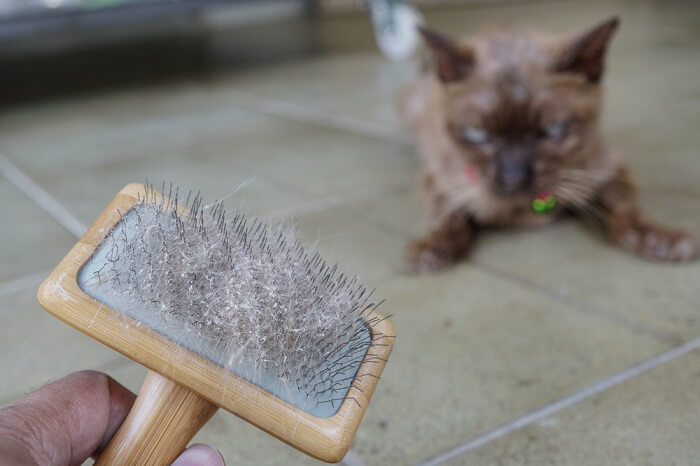
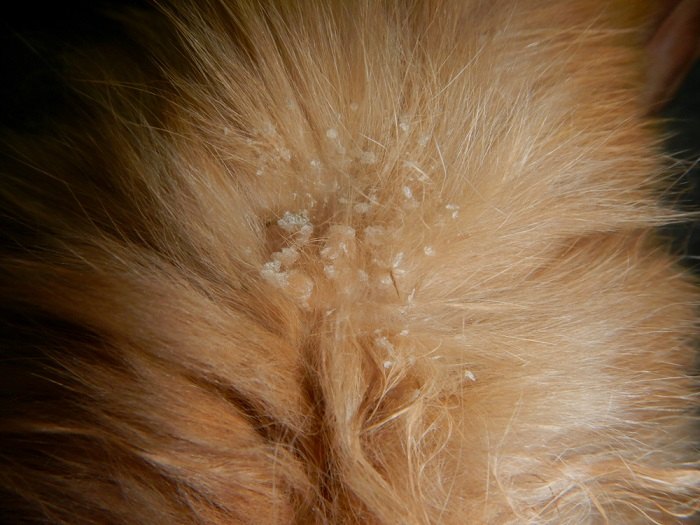
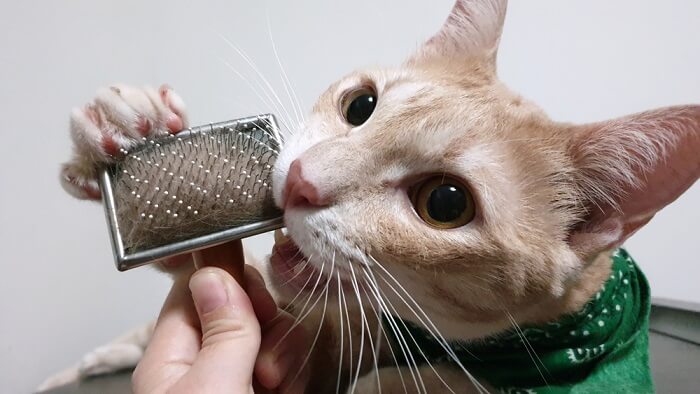
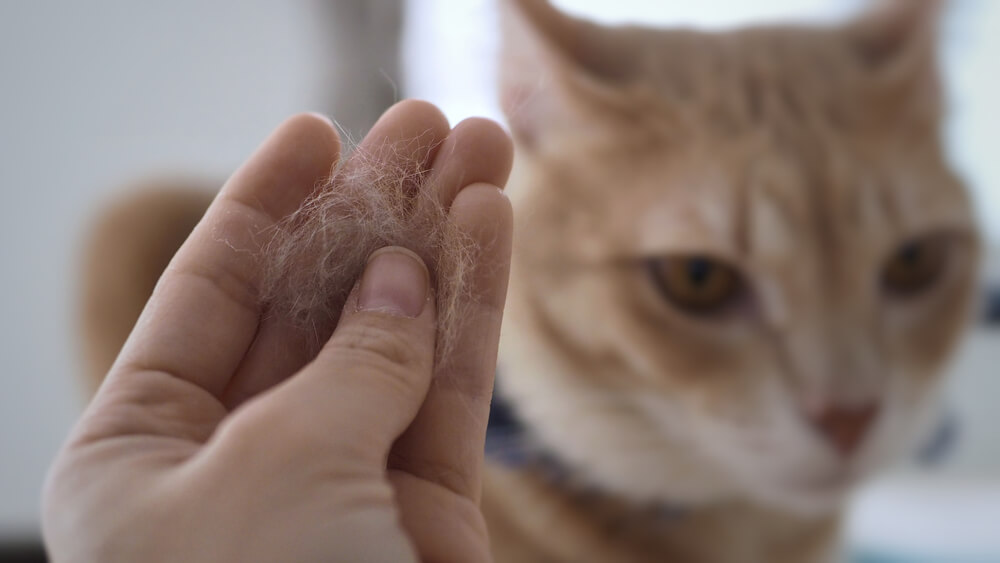


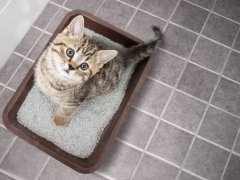





My cat seems to be obsessed with licking. He licks peoples skin, artificial flowers and plants, plastics, shoes, etc. If he goes outdoors he nibbles and eats grass. Otherwise he is a very nice playful cat. He will not eat wet food. I have offered nearly all brands and flavors and he just won’t eat them. He is Maine Coon mix, three years old and weighs 15 pounds. Why does he have this licking obsession?
Hi Deanna, that’s an interesting question! Your cat may just be curious or he may be showing signs of pica due to nutritional imbalances or as a behavioral issue. Consultation with a vet may shed more light on the issue.
Hello Deanna –
I agree with Mallory. Consulting with a vet is a good place to start. As she said, it may be a nutritional imbalance. Other possible causes include stress/anxiety, allergies, or even a viral infection.
Hi, I just wanted to leave a query! We currently have 2 cats, one calico Persian, and her son. Mum has had I think 2 flea treatments from the vets, as well as both the cats having at least 2/3 flea tablets (not all at once of course!) and also have had two different types of flea pipettes at home. None of these options had worked and they are still both scratching! We don’t tend to let them outside, as we had figured it may have been mum bringing the fleas home but nothing has really seemed to work. After reading this article, I have started to groom them more often, as they are longhair breeds, and I have seen some flaky residue on both of them. I hope you can help, what would you recommend we do? Thanks a lot!
– Cookies Kittens | Cat Breeder
Hi there. That’s a good question. Are both of the cats currently on flea preventive? I’d think that something like Frontline Plus would be the most effective solution to keep fleas off of your cats long-term. You’ll still have to think about treating the environment, but a preventive will make it easier. This article on getting rid of fleas and flea infestations may help you to develop a complete approach.
My cat is 14 yrs. She became very thin with hyperthyroidism. We went the Radiation route and she seemed fine. Then she
became very sick/thin with a stomach problem which was treated and she then started tearing out huge globs of her fur leaving bear patches the size of quarters…Finally Jackson Galaxy’s “Obsession ” helped. Now she has gained 10 lbs and
her fur has become much thicker than it was originally. She is hungry 24/7 and has bad dandruff. When I take her for her
blood work for her thyroid test she is “perfect” but I think she is somehow slightly hypothyroid now even though, which both
the weight and the fur would indicate…but all the Vets say as long as her blood work is OK she should not receive hormone
therapy. Her fur has become dry even though I feed her a very well-rated low cal dry food, plus normal wet food. She is an
outstanding cat in every way and this situation is very upsetting for both of us…could you shed some light on these symptoms? Thank you so much!
Hello Marlene, thank you for the comment. This is an excellent question, and I’m afraid it may be a bit out of my depth (not a veterinarian). I’d recommend ensuring that your cat has had a thyroid panel done during her blood testing, as this would show indicators of hypothyroidism. If this panel has been done and there aren’t any indicators of hypothyroidism, your best bet may be some dietary change to incorporate more omega-3s, which would help to support skin health and alleviate inflammation, and which is perhaps a bit more digestible for those stomach problems you mentioned. If you’d like direct support from a veterinarian, you can visit the All About Cats community.